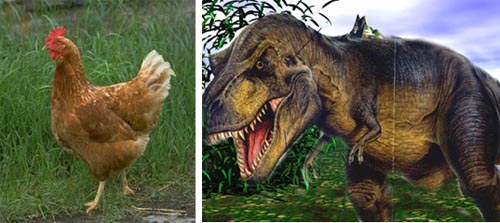T. Rex Linked to Chickens, Ostriches
The closest living relatives of Tyrannosaurus rex are birds such as chickens and ostriches, according to research published today in Science (and promptly reported in the New York Times). Paleontologists used material discovered in a chance find in 2003 to pin down the link.

The dinosaur-ness of birds has been suspected for many years based on anatomical similarities, but the new research is the first molecular evidence. For decades, dinosaurs were thought to be reptiles: big ones, to be sure, but basically cold-blooded, slow-moving, and dim-witted. The movie Jurassic Park popularized the idea of dinosaurs as quick, smart and birdlike. (The movie's ideas had been proposed in the 1970s--a book by paleontologist Robert Bakker, called The Dinosaur Heresies, nicely conveys this change in thinking and the controversy that accompanied it.)
To get molecular evidence about dinosaurs, you need some actual molecules--a tall order for a group of animals that died out 65 million years ago. But in 2003, scientists Jack Horner and Mary Schweitzer discovered some unfossilized material inside a T. rex bone by a combination of luck, desperation, and sharp eyes (see Smithsonian, May 2006). Faced with flying a giant femur out of a remote Montana field site, they broke the bone in half so it would fit inside their helicopter. If they'd had a larger helicopter, we might never have known.
Unlike in Jurassic Park, the real-life researchers couldn't recover any DNA from the ancient remains. But they did retrieve molecules of collagen, a structural protein that appears in slightly different forms in many animals. They compared the dinosaur version with 21 living animals, including humans, chimps, mice, chickens, ostriches, alligators and salmon. T. rex's collagen proved to be most similar to chickens and ostriches; its next closest match was to alligators.
Chickens and ostriches are only distantly related to each other, so the research says little about what kind of birds might be the closest relatives of the famous carnivore. The scientists noted that answering that question would require data from more molecules than just collagen. Whether they are currently cracking into any more giant fossils in search of material was not divulged.
(Images courtesy Science)